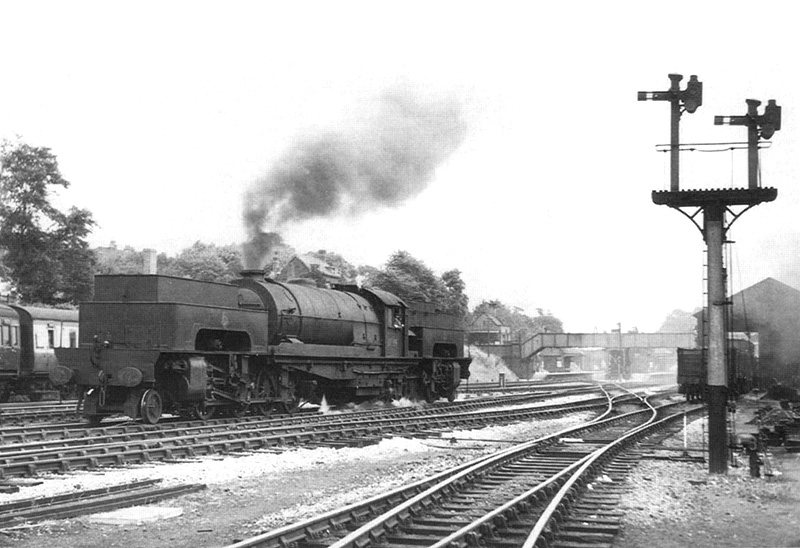 |
|
London North Western
Railway:

Midland
Railway:

Stratford
Midland Junction Railway
|

|
LMS Route: Evesham to Birmingham
Kings Norton Locomotives: mrkn791
 |
Ex-LNER 2-8-0-0-8-2 Garratt No 69999 is seen passing Kings
Norton carriage sidings on its way to be trialed as a Lickey Bank engine on 7th
August 1955. Its origins began in 1910 when the Great Central Railway initiated
the design of a 4-cylinder Garratt. This was probably based on a pre-existing
0-8-0 design (LNER class Q4), but over time the design evolved to use a 2-8-0
base (LNER class O4 ROD ) instead. This was approved by the LNER in 1924.
Initially there were plans for two such engines, although only one was built.
Between the initial order in 1924 and construction in 1925, the designed was
amended by Gresley to use 3 cylinders at each end, and to use some of the
motion from the O2 class. This lone engine (No 2395) was built by Beyer,
Peacock. The frames were laid on 1st June 1925, and was delivered to the LNER
on the 21st, ready to be displayed in shop grey at the Stockton &
Darlington Centenary celebrations on 1st July 1925. After the celebrations it
was painted in black, and entered service in August 1925. No. 2395 was the only
Garratt ever to serve with the LNER. It was the first mainline Garratt to enter
service in Britain, and it was the most powerful British locomotive of any
type. No 2395's prime duty was to bank coal trains up the Worsborough Incline
between Wentworth Junction and West Silkstone Junction. This incline was about
3.5 miles long at about 1 in 40. Typically coal trains of 60+ wagons arrived
from Wath pulled by an O4 with either an O4 or an L1 as a banker. No 2395 would
then come off its siding and couple up behind the banker. Once at West
Silkestone Junction, No 2395 would uncouple, and return to Wentworth Junction.
The train would continue to the main Sheffield to Manchester main line at
Penistone, whilst the other banker would usually remain until Dunford
Bridge.
Previous to No 2395's arrival, two O4s were used as extra
bankers, to give a total of three bankers! The Silkstone tunnels were
notoriously bad for air quality. The Garratt being at the back would suffer the
worst. Respirators were tried which took air from near rail-level, however the
loco crews objected to sharing equipment, and the trial stopped. The water was
very soft, so a protective layer of scale could not build up in No 2395's
tubes. Hence corrosion was a problem, and she was retubed in 1926. In 1927 the
firebox was cracked. In 1928, further firebox corrosion was found. A chemical
solution was tried from 1928, and this appears to have helped the corrosion
problems. However, she still spent 9 months of 1930 out of service for reasons
unknown. No 2395 was renumbered 9999 in March 1946, and then became 69999 with
Nationalisation. Despite these number changes, she kept the small 2395 cabside
numberplates until withdrawal. In 1949, it was realised that a new boiler would
be required soon. However, the forthcoming electrification scheme of the
Manchester, Sheffield, and Wath lines meant that this would only be economic if
alternative work could be found. She was also tried out on the Lickey Incline
in 1949-50 and again in 1955. Despite conversion to oil burning in 1952,
neither trial was a success. No. 69999 was withdrawn in December 1955 with a
final mileage of 425, 213 miles. Official accounts describe the final
withdrawal being due to the failure of the oil conversion, and widespread
unpopularity amongst engine crews. However, anecdotal reports also talk of the
London Midland Region's loading gauge restrictions and resulting platform
damage.
 back back

|
